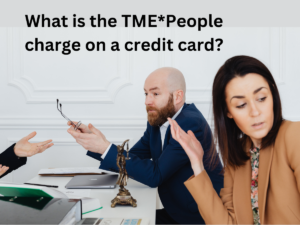In today’s digital age, credit card transactions have become an integral part of our daily lives. From online shopping to subscription services, our credit cards are constantly in use. However, with the convenience of credit cards comes the occasional confusion when we see unfamiliar charges on our statements.
One such charge that has left many cardholders scratching their heads is the “TMEPeople” charge. What exactly is this charge, and why does it appear on your credit card statement? In this article, we’ll delve into the details of the TMEPeople charge, exploring its origins, purpose, and what you should do if you encounter it.


What is the TME*People Charge?
The TME*People charge is a transaction descriptor that appears on credit card statements. It typically indicates a purchase or subscription related to a service provided by TME (Tencent Music Entertainment) or one of its affiliated platforms. TME is a leading online music entertainment platform in China, offering a wide range of music-related services, including streaming, downloads, and social features. The company operates several popular platforms, such as QQ Music, Kuwo Music, and Kugou Music, which are widely used by millions of users globally. When you see a TME*People charge on your credit card statement, it usually means that you or someone with access to your card has made a purchase or subscription through one of TME’s platforms. This could include anything from a premium music subscription to the purchase of virtual goods or in-app content.
Why Does the TME*People Charge Appear?
The TME*People charge appears on your credit card statement for several reasons, most of which are related to transactions made on TME’s platforms. Here are some common scenarios where you might encounter this charge:Music Streaming Subscriptions
One of the most common reasons for the TMEPeople charge is a subscription to one of TME’s music streaming services. TME offers various subscription plans that provide users with access to a vast library of music, ad-free listening, and other premium features. If you’ve signed up for a subscription on QQ Music, Kuwo Music, or Kugou Music, the charge will appear as TMEPeople on your credit card statement.In-App Purchases
TME’s platforms often offer in-app purchases, such as virtual gifts, stickers, or other digital content that users can buy to enhance their experience. If you’ve made any in-app purchases on these platforms, the charge will be reflected as TME*People on your statement.Gift Subscriptions
If someone has gifted you a subscription to one of TME’s services, the charge may appear on their credit card statement as TME*People. Similarly, if you’ve gifted a subscription to someone else, the charge will appear on your statement.Automatic Renewals
Many subscription services, including those offered by TME, come with automatic renewal features. This means that if you’ve subscribed to a service, your subscription will automatically renew at the end of the billing cycle, and the charge will appear as TME*People on your credit card statement.Unauthorized Transactions
In some cases, the TME*People charge may appear on your statement due to unauthorized transactions. This could happen if someone else has gained access to your credit card information and made a purchase or subscription on one of TME’s platforms without your knowledge.How to Identify the Source of the TME*People Charge?
If you’re unsure about the source of the TME*People charge on your credit card statement, there are several steps you can take to identify it:Review Your Purchase History
Start by reviewing your purchase history on TME’s platforms. Log in to your account on QQ Music, Kuwo Music, or Kugou Music, and check your transaction history to see if there are any purchases or subscriptions that match the charge on your statement.Check for Automatic Renewals
If you’ve previously subscribed to a TME service, it’s possible that the charge is due to an automatic renewal. Check your subscription settings on the platform to see if automatic renewal is enabled and if the charge corresponds to the renewal date.Verify Authorized Users
If you share your credit card with family members or friends, it’s possible that one of them made a purchase or subscription on TME’s platforms. Verify with any authorized users to see if they recognize the charge.Look for Unauthorized Transactions
If you’ve ruled out all other possibilities and still can’t identify the source of the charge, it’s possible that the transaction was unauthorized. In this case, you should take immediate steps to secure your credit card and dispute the charge with your card issuer.What to Do If You Don’t Recognize the TME*People Charge
If you don’t recognize the TME*People charge on your credit card statement, it’s important to take action promptly. Here’s what you should do:Contact TME Customer Support
The first step is to contact TME’s customer support team. Provide them with the details of the charge, including the date, amount, and transaction descriptor (TME*People). They should be able to provide you with more information about the transaction and help you determine if it was authorized.Dispute the Charge with Your Card Issuer
If you believe the charge is unauthorized, you should dispute it with your credit card issuer. Most card issuers have a process for disputing charges, and they will investigate the transaction on your behalf. If the charge is found to be fraudulent, you will typically be refunded the amount.Monitor Your Credit Card Statements
After disputing the charge, continue to monitor your credit card statements for any additional unauthorized transactions. If you notice any further suspicious activity, contact your card issuer immediately.Secure Your Credit Card Information
To prevent future unauthorized charges, take steps to secure your credit card information. This may include changing your passwords, enabling two-factor authentication on your accounts, and monitoring your credit card activity regularly.
How to Prevent Unwanted TME*People Charges
To avoid unwanted TME*People charges on your credit card, consider the following tips:Keep Track of Your Subscriptions
Make a list of all your active subscriptions, including those on TME’s platforms. Regularly review this list to ensure that you’re aware of all the services you’re paying for and cancel any subscriptions you no longer use.Disable Automatic Renewals
If you don’t want your subscriptions to automatically renew, consider disabling the automatic renewal feature. This will prevent unexpected charges from appearing on your credit card statement.Use Virtual Credit Cards
Some credit card issuers offer virtual credit cards that can be used for online transactions. These cards have a unique number that is different from your physical card, and you can set spending limits or expiration dates. Using a virtual credit card for online purchases can help protect your primary credit card information.Enable Transaction Alerts
Many credit card issuers offer transaction alerts that notify you of any charges made on your card. Enabling these alerts can help you quickly identify any unauthorized transactions and take action promptly.Regularly Review Your Credit Card Statements
Make it a habit to review your credit card statements regularly. This will help you catch any unfamiliar charges early and take action before they become a bigger issue.Are TeachYouWrite.com Charges Related to Credit Card Transaction Fees?
Many users express concern about potential hidden costs when signing up for services. In the case of TeachYouWrite. com, it’s important to review user experiences with teachyouwrite charges, as transaction fees may vary based on payment method and bank policies. Transparency in these charges is crucial for informed decision-making.
